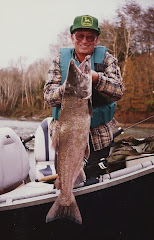Just like the Fall leaves turn to a crimson red, the Kokanee Salmon follow suit with their own transformation. Today was the annual Kokanee Salmon Day held at Strawberry Reservoir. It is a Day where the
Department of Wildlife Resources educates the public about this special species. There were also members of
Strawberry Anglers Association there talking about the programs they are involved with, and about how this blue-ribbon fishery is doing. They also had a guy showing you how to tie different fly patterns that work well on Strawberry.
 |
| The mountains are ablaze with Crimson leaves! |
 |
| Prepare to be amazed. |
Kokanee Salmon are typically a silvery-blue and sleek fish. When it's time to spawn, they turn to a crimson red and take on a beastly shape. After three to four years, Kokanee return to the same river where they were born to spawn. Once they spawn, they die like all other Salmon species. So what happens to let the Kokanee know it's time to start the spawning process? I asked one of the DWR officers, and she told me that it is all based on water temperature. In the Summer, water temperatures rise. In the Fall, the temperature cools, and when it hits 54 degrees fahrenheit, it triggers the Kokanee to start their journey back to the river where they started.
 |
| jockeying for position in the river. |
 |
| They find the right place and create a spawning bed. |
We took some time and watched the fish in the river before heading up to the fish trap. This is where the DWR take the kokanee and are able to collect both the sperm and eggs from the fish. They told me they have a lot higher success rate collecting the needed material and controlling the process at a hatchery. Once the kokanee reach three inches in length, The DWR returns the fish back to the river and the process is complete. There are other rivers flowing into Strawberry where natural reproduction takes place. Fishing is closed to all rivers while the Kokanee spawn is taking place, but you can fish right up to where the river enters the reservoir. More about that later...
 |
| A few Kokanee at the fish trap. The numbers were low this year. |
 |
| Nothing but net... |
 |
| getting ready for a demonstration. |
After learning more about these fish (including how to catch them), We drove around the lake to Haws Point to have a picnic. I got my portable BBQ out, and that is when I realized it wasn't a self-start. Guess who forgot to bring matches or a lighter? Luckily, another family had a lighter and let us borrow it. We ate and then explored for a bit. I fished, and other than seeing a 18-20 inch trout follow my spinner to shore, there was nothing!
We decided to go try a spot that a DWR officer mentioned. He told us that Kokanee stop eating weeks before they start to spawn. In fact, He said that once the Kokanee turn red, most don't even have a digestive system anymore! They are slowly starving to death. He said when something comes into their area, they strike it out of aggression, so to use something shiny or a small fish imitation. I took his advise and put on a plastic swim bait.
I found an area where I could see several Kokanee and began to fish. I had lots of follows and several hits before I had one slam it! FISH ON! It gave me a good fight, but it was over pretty quick. I had just landed my first Kokanee! To make things even better, it was a big male. Male Kokanee grow a big hump on their backs and their jaws start to curl in. They look gnarly which makes for a great picture!
On the way home we noticed a lot of kite surfers out on Deer Creek Reservoir. That sport looks like a blast and I want to give it a try in the future. We also got to take in the fall colors in Provo Canyon, and check out Bridal Veil Falls, which made for a beautiful ending to a great adventure!
 |
| Picnic at Haws Point. |
 |
| My first Kokanee with rod and reel! |
 |
| What a sweet release. |
 |
| The kite surfers were out in force on Deer Creek Reservoir. |
 |
| Provo Canyon on the way home. |
 |
| Bridal Veil Falls in Provo Canyon. The crowd gives perspective of the falls grandeur. |


















































